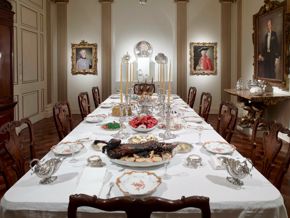English Taste: The Art of Dining in the Eighteenth Century September 17, 2011–January 29, 2012

English Taste: The Art of Dining in the Eighteenth Century
(September 2011–January 2012)
William Cripps, Epergne, 1754, silver, the Museum of Fine Arts, Houston, the Rienzi Collection, Museum purchase with funds provided by the Rienzi Society.
Paul Crespin, Pair of Sauceboats, 1752–53, sterling silver, the Museum of Fine Arts, Houston, the Rienzi Collection, Museum purchase with funds provided by the Rienzi Society, with additional gifts from Isla and Tommy Reckling, Windi and David Grimes, Hugh E. McGee, Mr. and Mrs. Charles W. Tate, and Meg Goodman and Mike Bonini.
English Taste: The Art of Dining in the Eighteenth Century
(September 2011–January 2012)
Elizabeth Raffald, portrait from the frontispiece of The Experienced English Housekeeper.
Private Collection
Elizabeth Raffald, diagram for the placement of dishes for a dinner’s second course,
from The Experienced English Housekeeper.
Private Collection
Elizabeth Raffald, opening page of first chapter of The Experienced English Housekeeper.
Private Collection
The 18th-century English dinner table was a feast for the eyes. In order to impress their guests and assure them that they were dining amid fashionable people of consequence, hosts served sumptuous dishes, adorned with towering sugar constructions and amusing trompe l'oeil (fool-the-eye) jellies of playing cards or bacon and eggs, all on exquisite silver and porcelain.
Rienzi re-creates this elaborate dining experience in English Taste: The Art of Dining in the Eighteenth Century. The first special exhibition ever held at Rienzi, the MFAH house museum for European decorative arts, English Taste treats you to a dining-room extravaganza typical of a 1760s English country house. Lifelike fish, fowl, and flummeries—complete with lavish, Georgian silver fittings and place settings—grace the table, created with guidance from the influential period cookbook The Experienced English Housekeeper by Elizabeth Raffald, the “Martha Stewart of the 18th century.”
Eminent English food historian Ivan Day uses Raffald’s recipes to create the faux foods—perhaps shockingly realistic to 21st-century eyes—which include roasted pheasant, beaked snipe, flummery jellies, and a larded hare. The meal also features macaroni and cheese (yes, this dish did exist in the 18th century!) made with imported pasta. Raffald’s illustration “Directions for a Grand Table” from 1769 serves as the design template for the installation.
This exhibition is organized by the Museum of Fine Arts, Houston.
